Introduction
Asexual reproduction—a process where organisms produce genetically identical offspring without genetic recombination—confers efficiency but imposes evolutionary constraints like mutation accumulation (Müller’s Ratchet) and limited adaptability . Recombinant DNA (rDNA) technology disrupts these constraints by introducing controlled genetic recombination into asexual systems. This article examines how rDNA transforms asexual reproduction from a static biological process into a dynamic platform for biomedical, agricultural, and biotechnological innovation.
1. Evolutionary Limits of Asexual Reproduction
Asexual reproduction relies on mitosis or budding, generating clones with near-identical genomes. Critical limitations include:
- Müller’s Ratchet: Irreversible accumulation of deleterious mutations across generations, reducing fitness .
- Clonal Interference: Beneficial mutations compete rather than combine, slowing adaptation .
- Genetic Stasis: Absence of recombination limits diversity to counter pathogens or environmental shifts .
Suggested Figure: Müller’s Ratchet in asexual lineages: Progressive accumulation of harmful mutations (red) vs. recombinant DNA-enabled correction (green).
2. Recombinant DNA: Engineering Genetic Diversity
rDNA technology splices genes from disparate sources into vectors (plasmids, viruses), creating hybrid DNA molecules. This enables:
- Targeted Trait Insertion: Introduction of beneficial genes (e.g., pathogen resistance, metabolic pathways) into asexual hosts like bacteria or yeast .
- Bypassing Evolutionary Barriers: In vitro combination of advantageous mutations, circumventing clonal interference .
Suggested Figure: rDNA workflow: Restriction enzyme digestion, ligation into plasmid vector, and bacterial transformation.
3. Synergy in Practice: rDNA Reshaping Asexual Systems
A. Bacterial Bioreactors
Asexual bacteria (e.g., E. coli) are engineered for:
- Therapeutic Protein Synthesis: Human insulin, Factor VIII, and growth hormone produced via plasmid vectors .
- Genetic Tool Development: Bacterial conjugation inspires rDNA delivery methods (e.g., electroporation) .
B. Yeast and Fungi
- Vaccine Production: Yeast-expressed hepatitis B surface antigen (HBsAg) replaces plasma-derived vaccines .
C. Agricultural Engineering
- Bt Cotton: Bacillus thuringiensis toxin gene insertion creates pest-resistant crops .
4. Overcoming Asexual Reproduction’s Deficits
rDNA directly counters asexuality’s weaknesses:
| Asexual Limitation | rDNA Solution |
|---|---|
| Müller’s Ratchet | Insertion of DNA repair genes (e.g., recA) via vectors . |
| Clonal Interference | In vitro recombination of beneficial mutations before host integration. |
| Low Genetic Diversity | Recombinant clone libraries enabling rapid trait screening . |
Suggested Figure: CRISPR-rDNA editing correcting a deleterious mutation in bacteria.
5. Industrial and Medical Transformations
- Scalable Biomanufacturing: Asexual cultures + rDNA enable production of:
- Monoclonal antibodies for cancer therapy .
- Recombinant PETase for plastic degradation .
- Gene Therapy: rDNA viral vectors (AAVs) deliver functional genes to human cells, compensating for genetic disorders .
6. Paradoxes and Ethical Dimensions
- Evolutionary Paradox: While asexuality avoids recombination costs (e.g., energy expenditure), rDNA imposes recombination to enhance functionality .
- Biosafety Concerns: rDNA-modified asexual organisms (GMOs) require stringent biocontainment to prevent ecological release .
7. Future Frontiers
- Synthetic Chassis Design: De novo engineered asexual organisms with plug-and-play rDNA modules.
- CRISPR-Directed Evolution: Accelerated crop adaptation via targeted recombination .
- Environmental Remediation: rDNA-edited algae for carbon capture or pollutant breakdown .
Suggested Figure: Engineered algae using rDNA pathways for biofuel synthesis.
Conclusion
Recombinant DNA technology and asexual reproduction share a relationship of engineered symbiosis. Where asexuality imposes evolutionary dead ends—genetic stagnation, mutation accumulation, and adaptive constraints—rDNA introduces precision recombination to unlock diversity, resilience, and innovation. This synergy powers biotherapeutics, sustainable agriculture, and environmental solutions. As synthetic biology advances, rDNA will transform asexual organisms from passive survivors into dynamic, human-directed agents of global change.
Data Source: Publicly available references.
Contact: chuanchuan810@gmail.com

